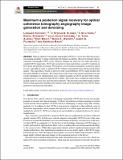Maximum a posteriori signal recovery for optical coherence tomography angiography image generation and denoising
Author(s)
Husvogt, Lennart; Chen, Siyu; Stromer, Daniel Johann; Moult, Eric Michael; Fujimoto, James G
DownloadPublished version (9.106Mb)
Publisher Policy
Publisher Policy
Article is made available in accordance with the publisher's policy and may be subject to US copyright law. Please refer to the publisher's site for terms of use.
Terms of use
Metadata
Show full item recordAbstract
Optical coherence tomography angiography (OCTA) is a novel and clinically promising imaging modality to image retinal and sub-retinal vasculature. Based on repeated optical coherence tomography (OCT) scans, intensity changes are observed over time and used to compute OCTA image data. OCTA data are prone to noise and artifacts caused by variations in flow speed and patient movement. We propose a novel iterative maximum a posteriori signal recovery algorithm in order to generate OCTA volumes with reduced noise and increased image quality. This algorithm is based on previous work on probabilistic OCTA signal models and maximum likelihood estimates. Reconstruction results using total variation minimization and wavelet shrinkage for regularization were compared against an OCTA ground truth volume, merged from six co-registered single OCTA volumes. The results show a significant improvement in peak signal-to-noise ratio and structural similarity. The presented algorithm brings together OCTA image generation and Bayesian statistics and can be developed into new OCTA image generation and denoising algorithms.
Date issued
2021-01Department
Massachusetts Institute of Technology. Research Laboratory of Electronics; Massachusetts Institute of Technology. Institute for Medical Engineering & Science; Massachusetts Institute of Technology. Department of Electrical Engineering and Computer ScienceJournal
Biomedical Optics Express
Publisher
The Optical Society
Citation
Husvogt, Lennart et al. “Maximum a posteriori signal recovery for optical coherence tomography angiography image generation and denoising.” Biomedical Optics Express, 12, 1 (January 2021): © 2021 The Author(s)
Version: Final published version
ISSN
2156-7085